Corporate Accounting Report: Standard Setting and Analysis
VerifiedAdded on 2023/06/07
|15
|2892
|148
Report
AI Summary
This report delves into the realm of corporate accounting, emphasizing the significance of voluntary financial information disclosure and the role of regulation in ensuring accurate and reliable financial reporting. It highlights the importance of aligning debt and equity components for an optimal capital structure, thereby reducing financial leverage and cost of capital. The report explores the role of the Australian Accounting Standards Board (AASB) in the global accounting standard-setting process, including its collaboration with the IASB and the challenges faced by companies in implementing IFRS. Furthermore, it provides an equity analysis of four ASX-listed companies, examining their debt and equity positions over a four-year period. The analysis covers key financial aspects such as share capital, retained earnings, and reserves. The report concludes with key findings related to corporate accounting practices, financial reporting, and the financial performance of the selected companies.
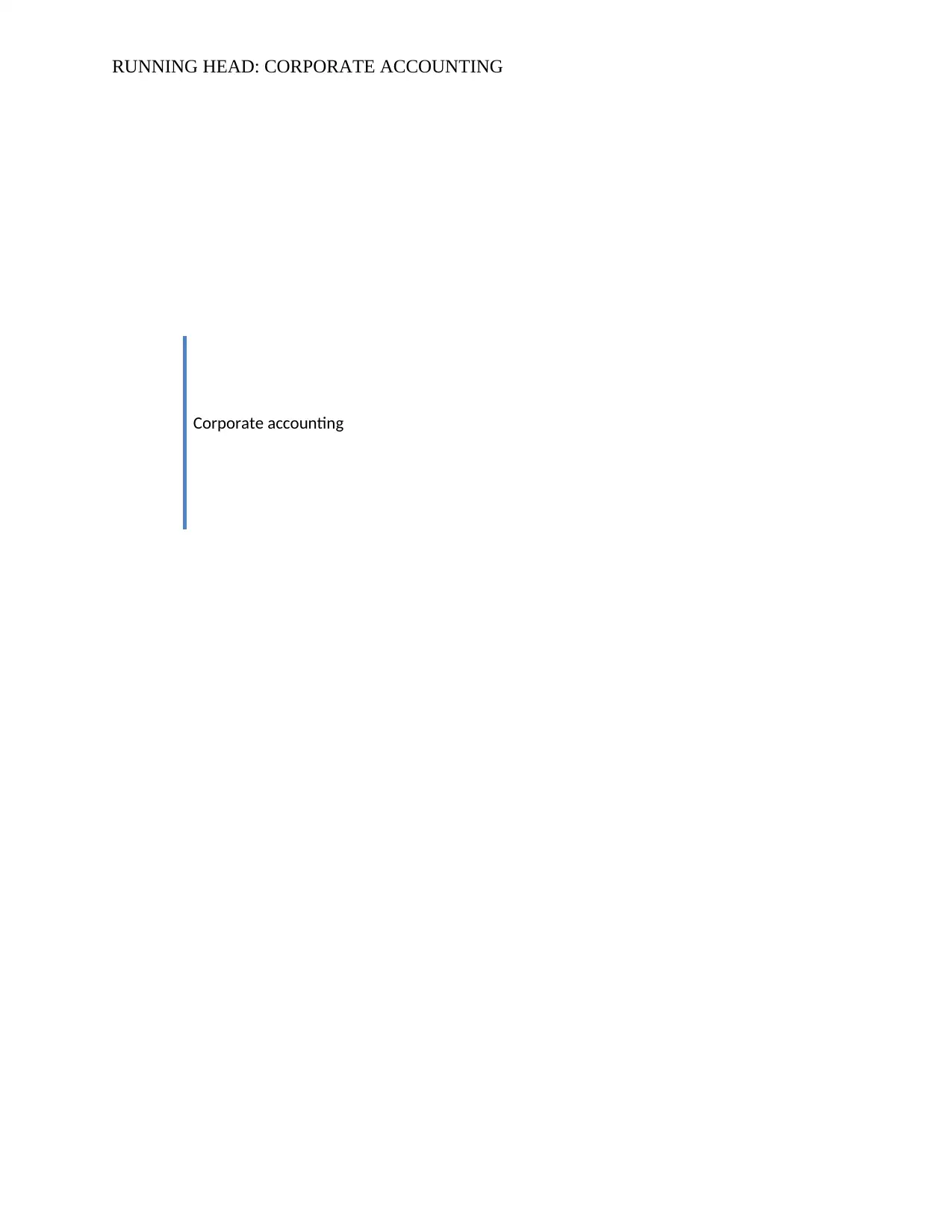
RUNNING HEAD: CORPORATE ACCOUNTING
Corporate accounting
Corporate accounting
Paraphrase This Document
Need a fresh take? Get an instant paraphrase of this document with our AI Paraphraser
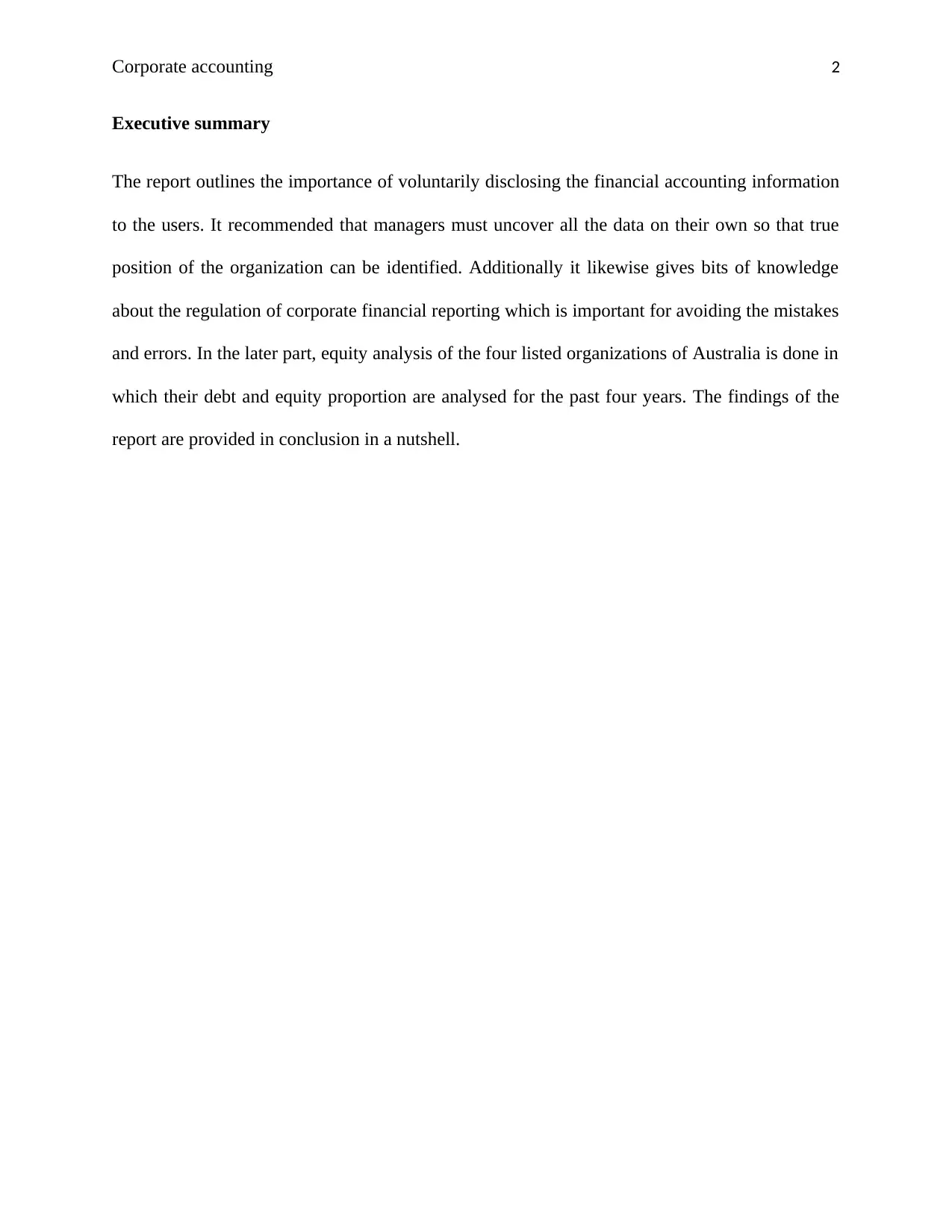
Corporate accounting 2
Executive summary
The report outlines the importance of voluntarily disclosing the financial accounting information
to the users. It recommended that managers must uncover all the data on their own so that true
position of the organization can be identified. Additionally it likewise gives bits of knowledge
about the regulation of corporate financial reporting which is important for avoiding the mistakes
and errors. In the later part, equity analysis of the four listed organizations of Australia is done in
which their debt and equity proportion are analysed for the past four years. The findings of the
report are provided in conclusion in a nutshell.
Executive summary
The report outlines the importance of voluntarily disclosing the financial accounting information
to the users. It recommended that managers must uncover all the data on their own so that true
position of the organization can be identified. Additionally it likewise gives bits of knowledge
about the regulation of corporate financial reporting which is important for avoiding the mistakes
and errors. In the later part, equity analysis of the four listed organizations of Australia is done in
which their debt and equity proportion are analysed for the past four years. The findings of the
report are provided in conclusion in a nutshell.
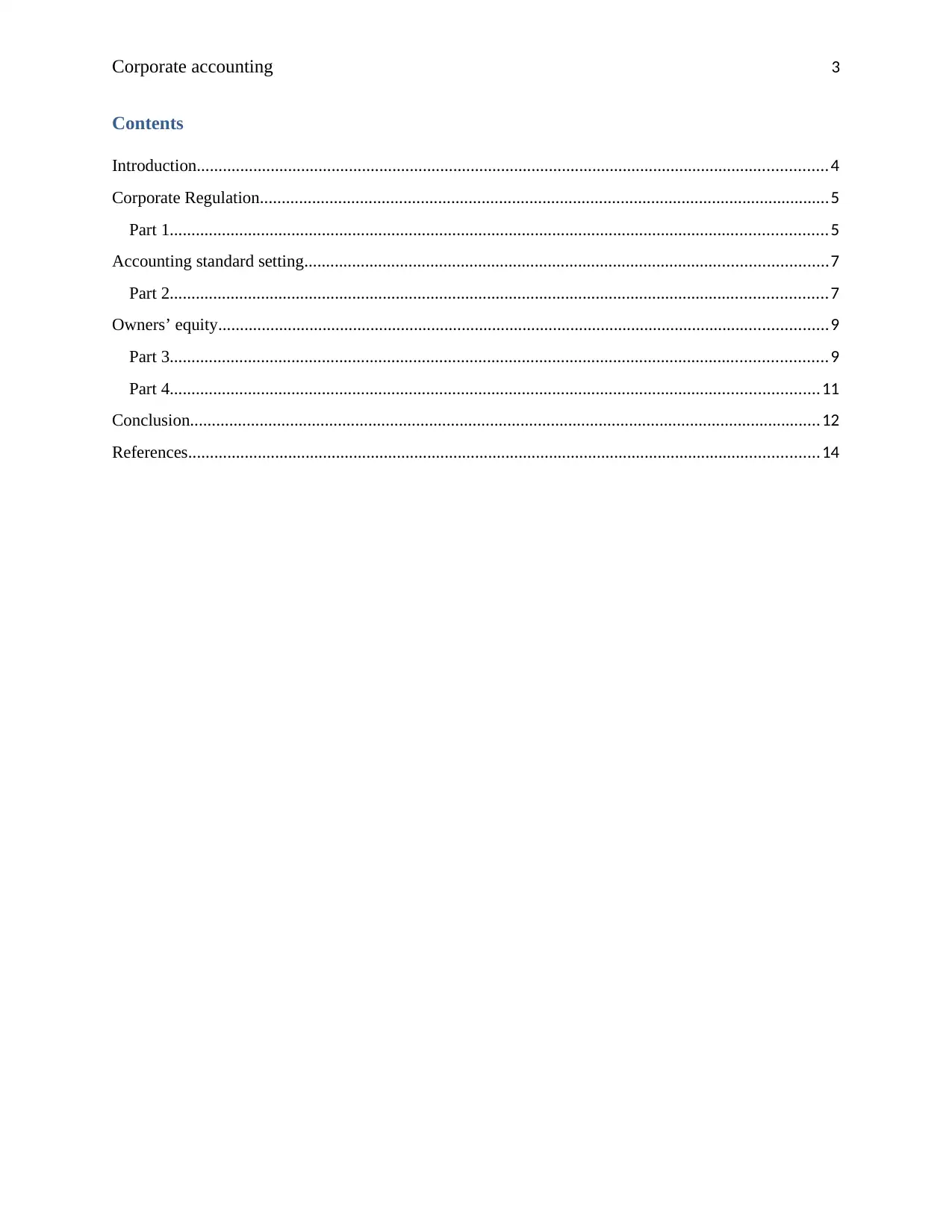
Corporate accounting 3
Contents
Introduction.................................................................................................................................................4
Corporate Regulation...................................................................................................................................5
Part 1.......................................................................................................................................................5
Accounting standard setting........................................................................................................................7
Part 2.......................................................................................................................................................7
Owners’ equity............................................................................................................................................9
Part 3.......................................................................................................................................................9
Part 4.....................................................................................................................................................11
Conclusion.................................................................................................................................................12
References.................................................................................................................................................14
Contents
Introduction.................................................................................................................................................4
Corporate Regulation...................................................................................................................................5
Part 1.......................................................................................................................................................5
Accounting standard setting........................................................................................................................7
Part 2.......................................................................................................................................................7
Owners’ equity............................................................................................................................................9
Part 3.......................................................................................................................................................9
Part 4.....................................................................................................................................................11
Conclusion.................................................................................................................................................12
References.................................................................................................................................................14
⊘ This is a preview!⊘
Do you want full access?
Subscribe today to unlock all pages.

Trusted by 1+ million students worldwide
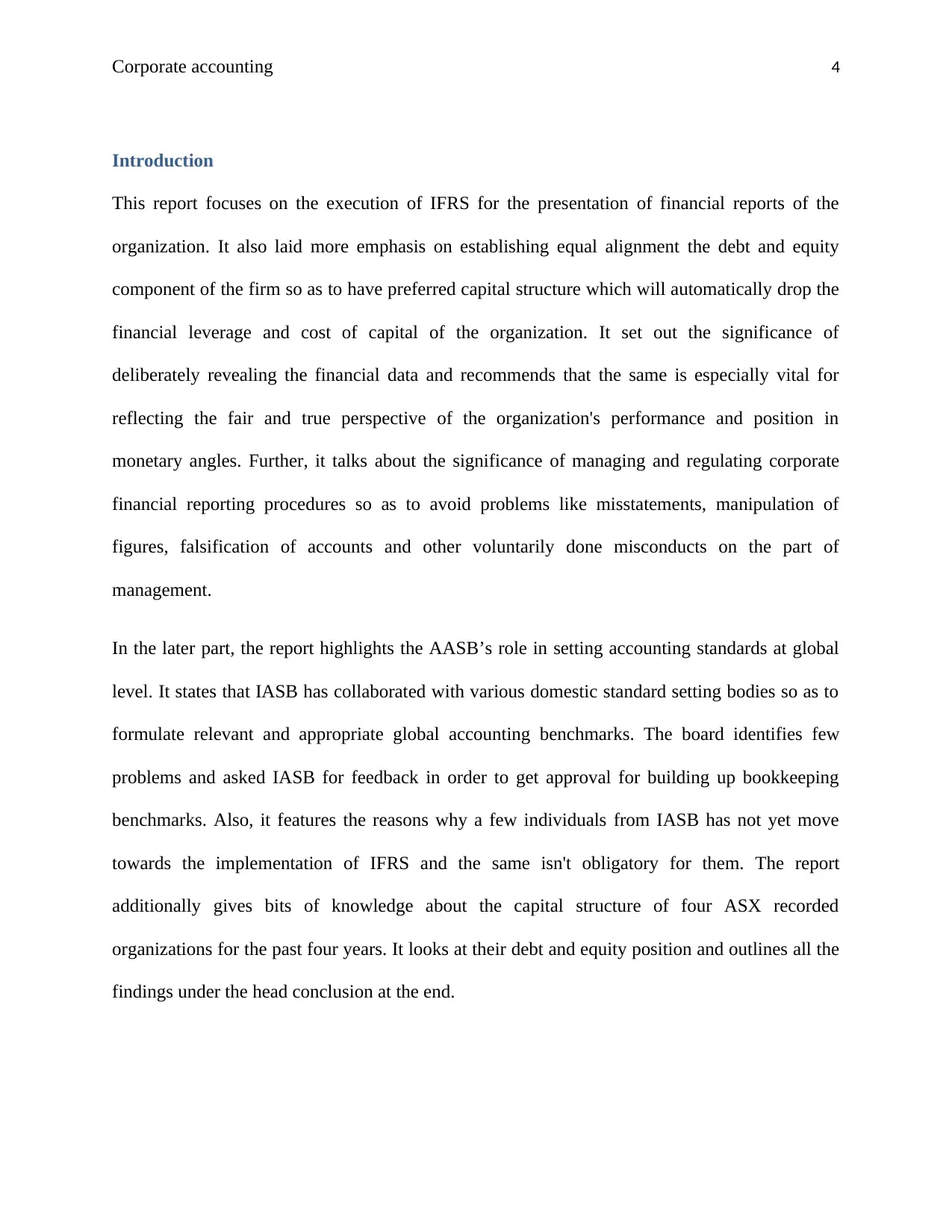
Corporate accounting 4
Introduction
This report focuses on the execution of IFRS for the presentation of financial reports of the
organization. It also laid more emphasis on establishing equal alignment the debt and equity
component of the firm so as to have preferred capital structure which will automatically drop the
financial leverage and cost of capital of the organization. It set out the significance of
deliberately revealing the financial data and recommends that the same is especially vital for
reflecting the fair and true perspective of the organization's performance and position in
monetary angles. Further, it talks about the significance of managing and regulating corporate
financial reporting procedures so as to avoid problems like misstatements, manipulation of
figures, falsification of accounts and other voluntarily done misconducts on the part of
management.
In the later part, the report highlights the AASB’s role in setting accounting standards at global
level. It states that IASB has collaborated with various domestic standard setting bodies so as to
formulate relevant and appropriate global accounting benchmarks. The board identifies few
problems and asked IASB for feedback in order to get approval for building up bookkeeping
benchmarks. Also, it features the reasons why a few individuals from IASB has not yet move
towards the implementation of IFRS and the same isn't obligatory for them. The report
additionally gives bits of knowledge about the capital structure of four ASX recorded
organizations for the past four years. It looks at their debt and equity position and outlines all the
findings under the head conclusion at the end.
Introduction
This report focuses on the execution of IFRS for the presentation of financial reports of the
organization. It also laid more emphasis on establishing equal alignment the debt and equity
component of the firm so as to have preferred capital structure which will automatically drop the
financial leverage and cost of capital of the organization. It set out the significance of
deliberately revealing the financial data and recommends that the same is especially vital for
reflecting the fair and true perspective of the organization's performance and position in
monetary angles. Further, it talks about the significance of managing and regulating corporate
financial reporting procedures so as to avoid problems like misstatements, manipulation of
figures, falsification of accounts and other voluntarily done misconducts on the part of
management.
In the later part, the report highlights the AASB’s role in setting accounting standards at global
level. It states that IASB has collaborated with various domestic standard setting bodies so as to
formulate relevant and appropriate global accounting benchmarks. The board identifies few
problems and asked IASB for feedback in order to get approval for building up bookkeeping
benchmarks. Also, it features the reasons why a few individuals from IASB has not yet move
towards the implementation of IFRS and the same isn't obligatory for them. The report
additionally gives bits of knowledge about the capital structure of four ASX recorded
organizations for the past four years. It looks at their debt and equity position and outlines all the
findings under the head conclusion at the end.
Paraphrase This Document
Need a fresh take? Get an instant paraphrase of this document with our AI Paraphraser
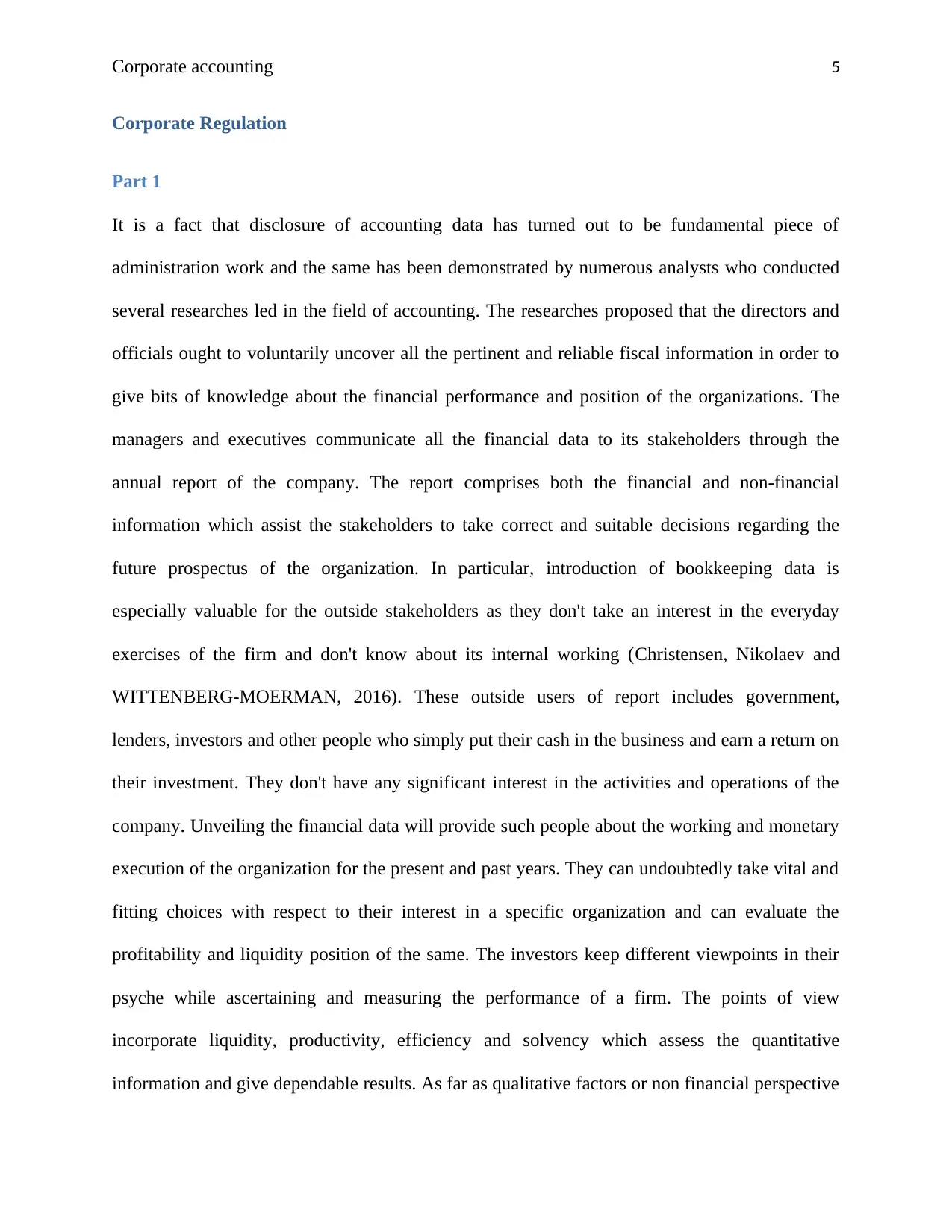
Corporate accounting 5
Corporate Regulation
Part 1
It is a fact that disclosure of accounting data has turned out to be fundamental piece of
administration work and the same has been demonstrated by numerous analysts who conducted
several researches led in the field of accounting. The researches proposed that the directors and
officials ought to voluntarily uncover all the pertinent and reliable fiscal information in order to
give bits of knowledge about the financial performance and position of the organizations. The
managers and executives communicate all the financial data to its stakeholders through the
annual report of the company. The report comprises both the financial and non-financial
information which assist the stakeholders to take correct and suitable decisions regarding the
future prospectus of the organization. In particular, introduction of bookkeeping data is
especially valuable for the outside stakeholders as they don't take an interest in the everyday
exercises of the firm and don't know about its internal working (Christensen, Nikolaev and
WITTENBERG‐MOERMAN, 2016). These outside users of report includes government,
lenders, investors and other people who simply put their cash in the business and earn a return on
their investment. They don't have any significant interest in the activities and operations of the
company. Unveiling the financial data will provide such people about the working and monetary
execution of the organization for the present and past years. They can undoubtedly take vital and
fitting choices with respect to their interest in a specific organization and can evaluate the
profitability and liquidity position of the same. The investors keep different viewpoints in their
psyche while ascertaining and measuring the performance of a firm. The points of view
incorporate liquidity, productivity, efficiency and solvency which assess the quantitative
information and give dependable results. As far as qualitative factors or non financial perspective
Corporate Regulation
Part 1
It is a fact that disclosure of accounting data has turned out to be fundamental piece of
administration work and the same has been demonstrated by numerous analysts who conducted
several researches led in the field of accounting. The researches proposed that the directors and
officials ought to voluntarily uncover all the pertinent and reliable fiscal information in order to
give bits of knowledge about the financial performance and position of the organizations. The
managers and executives communicate all the financial data to its stakeholders through the
annual report of the company. The report comprises both the financial and non-financial
information which assist the stakeholders to take correct and suitable decisions regarding the
future prospectus of the organization. In particular, introduction of bookkeeping data is
especially valuable for the outside stakeholders as they don't take an interest in the everyday
exercises of the firm and don't know about its internal working (Christensen, Nikolaev and
WITTENBERG‐MOERMAN, 2016). These outside users of report includes government,
lenders, investors and other people who simply put their cash in the business and earn a return on
their investment. They don't have any significant interest in the activities and operations of the
company. Unveiling the financial data will provide such people about the working and monetary
execution of the organization for the present and past years. They can undoubtedly take vital and
fitting choices with respect to their interest in a specific organization and can evaluate the
profitability and liquidity position of the same. The investors keep different viewpoints in their
psyche while ascertaining and measuring the performance of a firm. The points of view
incorporate liquidity, productivity, efficiency and solvency which assess the quantitative
information and give dependable results. As far as qualitative factors or non financial perspective
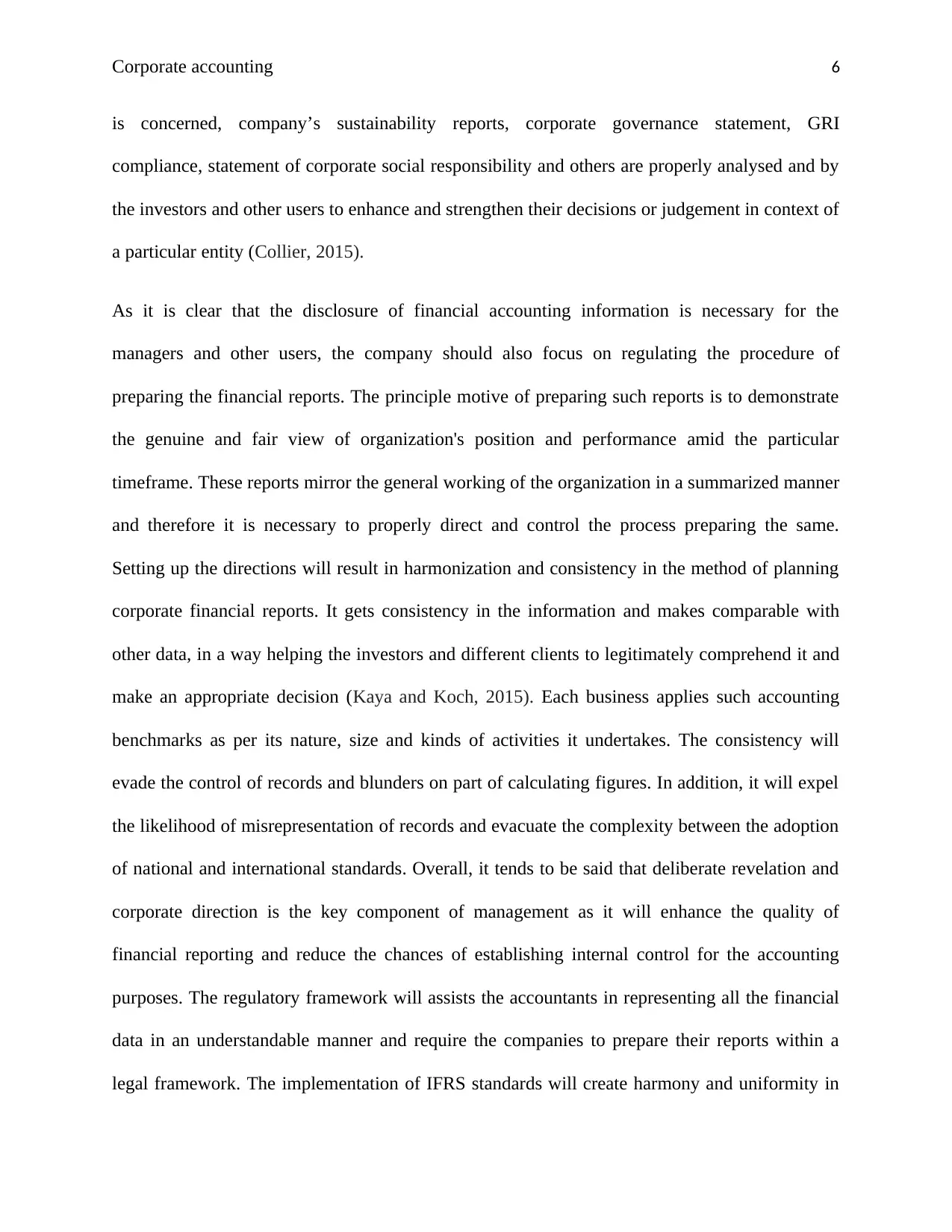
Corporate accounting 6
is concerned, company’s sustainability reports, corporate governance statement, GRI
compliance, statement of corporate social responsibility and others are properly analysed and by
the investors and other users to enhance and strengthen their decisions or judgement in context of
a particular entity (Collier, 2015).
As it is clear that the disclosure of financial accounting information is necessary for the
managers and other users, the company should also focus on regulating the procedure of
preparing the financial reports. The principle motive of preparing such reports is to demonstrate
the genuine and fair view of organization's position and performance amid the particular
timeframe. These reports mirror the general working of the organization in a summarized manner
and therefore it is necessary to properly direct and control the process preparing the same.
Setting up the directions will result in harmonization and consistency in the method of planning
corporate financial reports. It gets consistency in the information and makes comparable with
other data, in a way helping the investors and different clients to legitimately comprehend it and
make an appropriate decision (Kaya and Koch, 2015). Each business applies such accounting
benchmarks as per its nature, size and kinds of activities it undertakes. The consistency will
evade the control of records and blunders on part of calculating figures. In addition, it will expel
the likelihood of misrepresentation of records and evacuate the complexity between the adoption
of national and international standards. Overall, it tends to be said that deliberate revelation and
corporate direction is the key component of management as it will enhance the quality of
financial reporting and reduce the chances of establishing internal control for the accounting
purposes. The regulatory framework will assists the accountants in representing all the financial
data in an understandable manner and require the companies to prepare their reports within a
legal framework. The implementation of IFRS standards will create harmony and uniformity in
is concerned, company’s sustainability reports, corporate governance statement, GRI
compliance, statement of corporate social responsibility and others are properly analysed and by
the investors and other users to enhance and strengthen their decisions or judgement in context of
a particular entity (Collier, 2015).
As it is clear that the disclosure of financial accounting information is necessary for the
managers and other users, the company should also focus on regulating the procedure of
preparing the financial reports. The principle motive of preparing such reports is to demonstrate
the genuine and fair view of organization's position and performance amid the particular
timeframe. These reports mirror the general working of the organization in a summarized manner
and therefore it is necessary to properly direct and control the process preparing the same.
Setting up the directions will result in harmonization and consistency in the method of planning
corporate financial reports. It gets consistency in the information and makes comparable with
other data, in a way helping the investors and different clients to legitimately comprehend it and
make an appropriate decision (Kaya and Koch, 2015). Each business applies such accounting
benchmarks as per its nature, size and kinds of activities it undertakes. The consistency will
evade the control of records and blunders on part of calculating figures. In addition, it will expel
the likelihood of misrepresentation of records and evacuate the complexity between the adoption
of national and international standards. Overall, it tends to be said that deliberate revelation and
corporate direction is the key component of management as it will enhance the quality of
financial reporting and reduce the chances of establishing internal control for the accounting
purposes. The regulatory framework will assists the accountants in representing all the financial
data in an understandable manner and require the companies to prepare their reports within a
legal framework. The implementation of IFRS standards will create harmony and uniformity in
⊘ This is a preview!⊘
Do you want full access?
Subscribe today to unlock all pages.

Trusted by 1+ million students worldwide
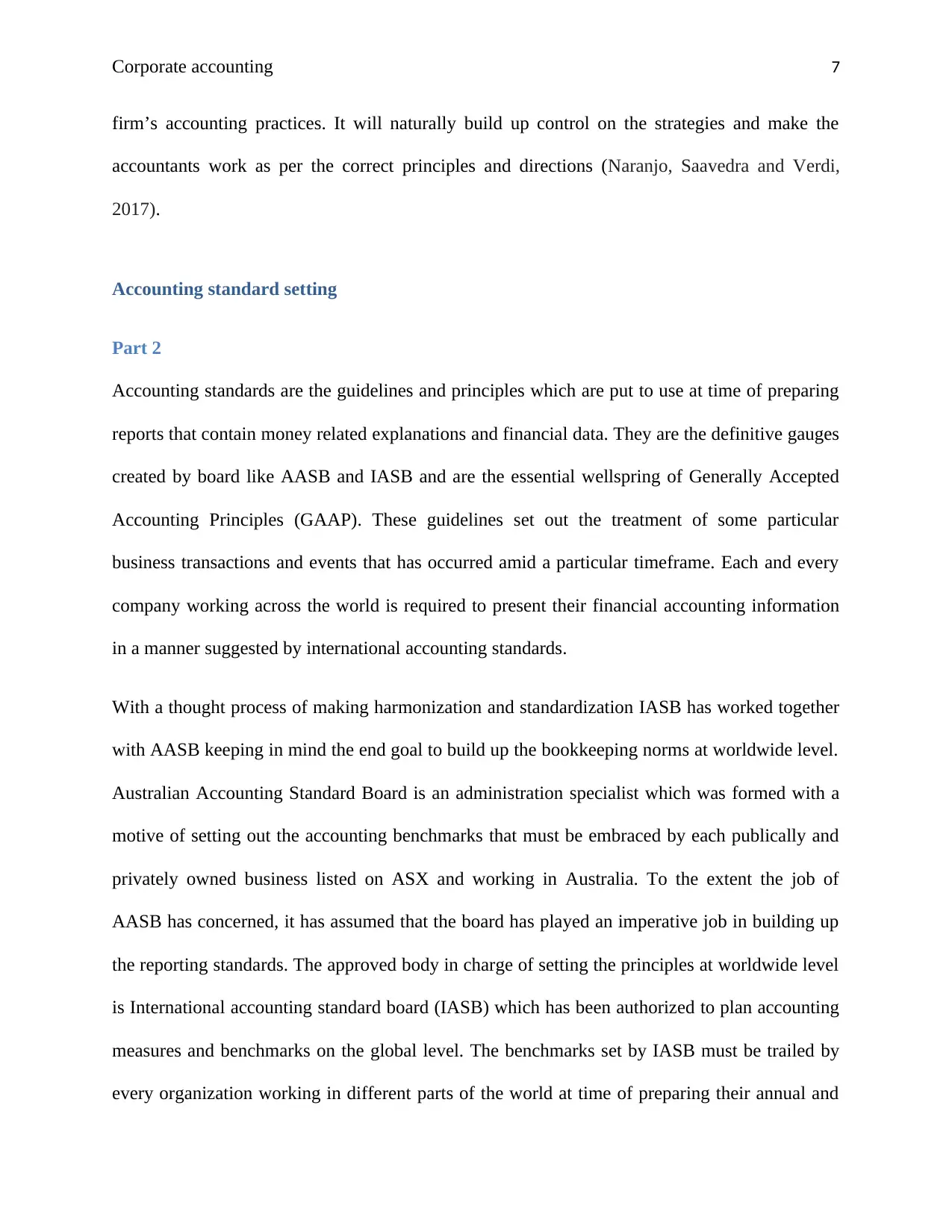
Corporate accounting 7
firm’s accounting practices. It will naturally build up control on the strategies and make the
accountants work as per the correct principles and directions (Naranjo, Saavedra and Verdi,
2017).
Accounting standard setting
Part 2
Accounting standards are the guidelines and principles which are put to use at time of preparing
reports that contain money related explanations and financial data. They are the definitive gauges
created by board like AASB and IASB and are the essential wellspring of Generally Accepted
Accounting Principles (GAAP). These guidelines set out the treatment of some particular
business transactions and events that has occurred amid a particular timeframe. Each and every
company working across the world is required to present their financial accounting information
in a manner suggested by international accounting standards.
With a thought process of making harmonization and standardization IASB has worked together
with AASB keeping in mind the end goal to build up the bookkeeping norms at worldwide level.
Australian Accounting Standard Board is an administration specialist which was formed with a
motive of setting out the accounting benchmarks that must be embraced by each publically and
privately owned business listed on ASX and working in Australia. To the extent the job of
AASB has concerned, it has assumed that the board has played an imperative job in building up
the reporting standards. The approved body in charge of setting the principles at worldwide level
is International accounting standard board (IASB) which has been authorized to plan accounting
measures and benchmarks on the global level. The benchmarks set by IASB must be trailed by
every organization working in different parts of the world at time of preparing their annual and
firm’s accounting practices. It will naturally build up control on the strategies and make the
accountants work as per the correct principles and directions (Naranjo, Saavedra and Verdi,
2017).
Accounting standard setting
Part 2
Accounting standards are the guidelines and principles which are put to use at time of preparing
reports that contain money related explanations and financial data. They are the definitive gauges
created by board like AASB and IASB and are the essential wellspring of Generally Accepted
Accounting Principles (GAAP). These guidelines set out the treatment of some particular
business transactions and events that has occurred amid a particular timeframe. Each and every
company working across the world is required to present their financial accounting information
in a manner suggested by international accounting standards.
With a thought process of making harmonization and standardization IASB has worked together
with AASB keeping in mind the end goal to build up the bookkeeping norms at worldwide level.
Australian Accounting Standard Board is an administration specialist which was formed with a
motive of setting out the accounting benchmarks that must be embraced by each publically and
privately owned business listed on ASX and working in Australia. To the extent the job of
AASB has concerned, it has assumed that the board has played an imperative job in building up
the reporting standards. The approved body in charge of setting the principles at worldwide level
is International accounting standard board (IASB) which has been authorized to plan accounting
measures and benchmarks on the global level. The benchmarks set by IASB must be trailed by
every organization working in different parts of the world at time of preparing their annual and
Paraphrase This Document
Need a fresh take? Get an instant paraphrase of this document with our AI Paraphraser
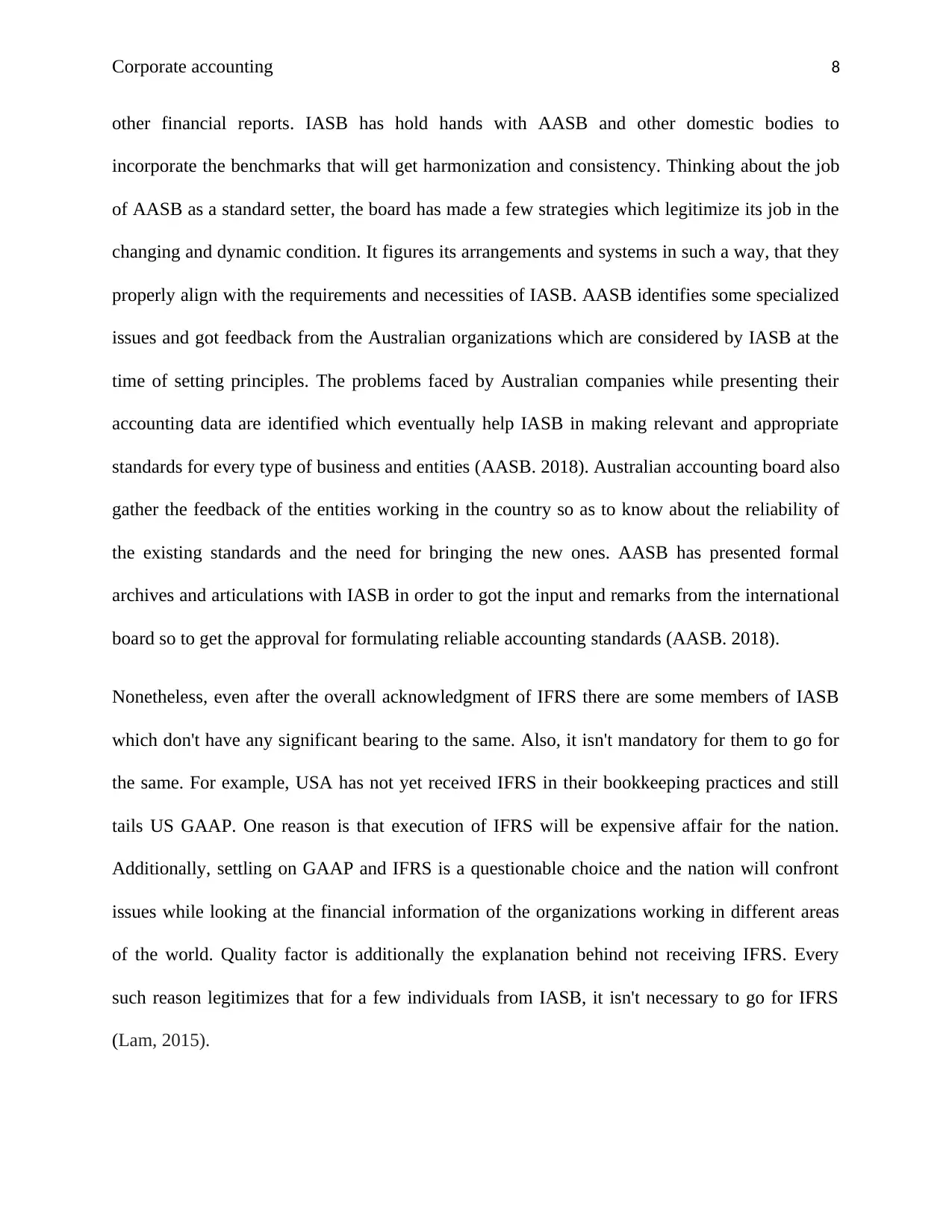
Corporate accounting 8
other financial reports. IASB has hold hands with AASB and other domestic bodies to
incorporate the benchmarks that will get harmonization and consistency. Thinking about the job
of AASB as a standard setter, the board has made a few strategies which legitimize its job in the
changing and dynamic condition. It figures its arrangements and systems in such a way, that they
properly align with the requirements and necessities of IASB. AASB identifies some specialized
issues and got feedback from the Australian organizations which are considered by IASB at the
time of setting principles. The problems faced by Australian companies while presenting their
accounting data are identified which eventually help IASB in making relevant and appropriate
standards for every type of business and entities (AASB. 2018). Australian accounting board also
gather the feedback of the entities working in the country so as to know about the reliability of
the existing standards and the need for bringing the new ones. AASB has presented formal
archives and articulations with IASB in order to got the input and remarks from the international
board so to get the approval for formulating reliable accounting standards (AASB. 2018).
Nonetheless, even after the overall acknowledgment of IFRS there are some members of IASB
which don't have any significant bearing to the same. Also, it isn't mandatory for them to go for
the same. For example, USA has not yet received IFRS in their bookkeeping practices and still
tails US GAAP. One reason is that execution of IFRS will be expensive affair for the nation.
Additionally, settling on GAAP and IFRS is a questionable choice and the nation will confront
issues while looking at the financial information of the organizations working in different areas
of the world. Quality factor is additionally the explanation behind not receiving IFRS. Every
such reason legitimizes that for a few individuals from IASB, it isn't necessary to go for IFRS
(Lam, 2015).
other financial reports. IASB has hold hands with AASB and other domestic bodies to
incorporate the benchmarks that will get harmonization and consistency. Thinking about the job
of AASB as a standard setter, the board has made a few strategies which legitimize its job in the
changing and dynamic condition. It figures its arrangements and systems in such a way, that they
properly align with the requirements and necessities of IASB. AASB identifies some specialized
issues and got feedback from the Australian organizations which are considered by IASB at the
time of setting principles. The problems faced by Australian companies while presenting their
accounting data are identified which eventually help IASB in making relevant and appropriate
standards for every type of business and entities (AASB. 2018). Australian accounting board also
gather the feedback of the entities working in the country so as to know about the reliability of
the existing standards and the need for bringing the new ones. AASB has presented formal
archives and articulations with IASB in order to got the input and remarks from the international
board so to get the approval for formulating reliable accounting standards (AASB. 2018).
Nonetheless, even after the overall acknowledgment of IFRS there are some members of IASB
which don't have any significant bearing to the same. Also, it isn't mandatory for them to go for
the same. For example, USA has not yet received IFRS in their bookkeeping practices and still
tails US GAAP. One reason is that execution of IFRS will be expensive affair for the nation.
Additionally, settling on GAAP and IFRS is a questionable choice and the nation will confront
issues while looking at the financial information of the organizations working in different areas
of the world. Quality factor is additionally the explanation behind not receiving IFRS. Every
such reason legitimizes that for a few individuals from IASB, it isn't necessary to go for IFRS
(Lam, 2015).
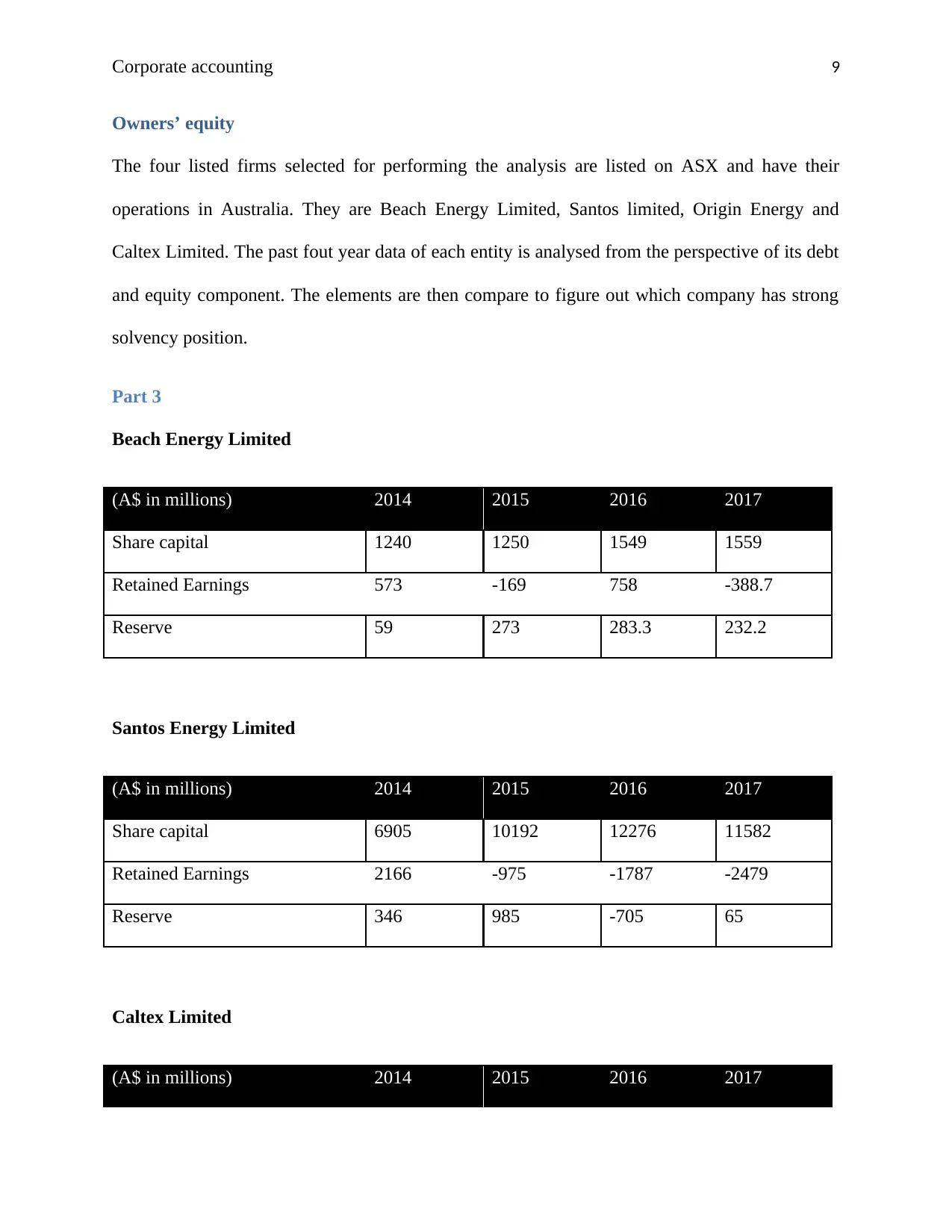
Corporate accounting 9
Owners’ equity
The four listed firms selected for performing the analysis are listed on ASX and have their
operations in Australia. They are Beach Energy Limited, Santos limited, Origin Energy and
Caltex Limited. The past fout year data of each entity is analysed from the perspective of its debt
and equity component. The elements are then compare to figure out which company has strong
solvency position.
Part 3
Beach Energy Limited
(A$ in millions) 2014 2015 2016 2017
Share capital 1240 1250 1549 1559
Retained Earnings 573 -169 758 -388.7
Reserve 59 273 283.3 232.2
Santos Energy Limited
(A$ in millions) 2014 2015 2016 2017
Share capital 6905 10192 12276 11582
Retained Earnings 2166 -975 -1787 -2479
Reserve 346 985 -705 65
Caltex Limited
(A$ in millions) 2014 2015 2016 2017
Owners’ equity
The four listed firms selected for performing the analysis are listed on ASX and have their
operations in Australia. They are Beach Energy Limited, Santos limited, Origin Energy and
Caltex Limited. The past fout year data of each entity is analysed from the perspective of its debt
and equity component. The elements are then compare to figure out which company has strong
solvency position.
Part 3
Beach Energy Limited
(A$ in millions) 2014 2015 2016 2017
Share capital 1240 1250 1549 1559
Retained Earnings 573 -169 758 -388.7
Reserve 59 273 283.3 232.2
Santos Energy Limited
(A$ in millions) 2014 2015 2016 2017
Share capital 6905 10192 12276 11582
Retained Earnings 2166 -975 -1787 -2479
Reserve 346 985 -705 65
Caltex Limited
(A$ in millions) 2014 2015 2016 2017
⊘ This is a preview!⊘
Do you want full access?
Subscribe today to unlock all pages.

Trusted by 1+ million students worldwide
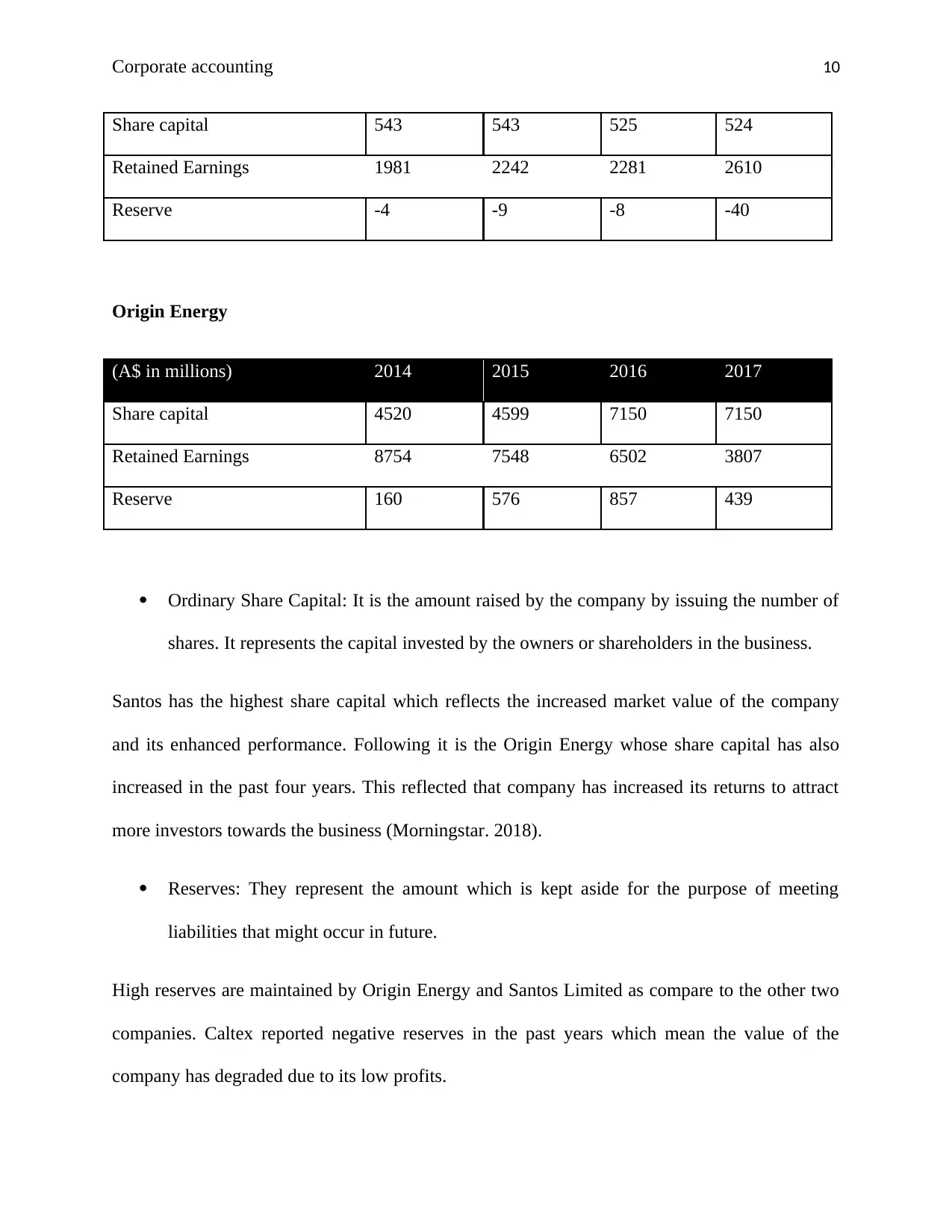
Corporate accounting 10
Share capital 543 543 525 524
Retained Earnings 1981 2242 2281 2610
Reserve -4 -9 -8 -40
Origin Energy
(A$ in millions) 2014 2015 2016 2017
Share capital 4520 4599 7150 7150
Retained Earnings 8754 7548 6502 3807
Reserve 160 576 857 439
Ordinary Share Capital: It is the amount raised by the company by issuing the number of
shares. It represents the capital invested by the owners or shareholders in the business.
Santos has the highest share capital which reflects the increased market value of the company
and its enhanced performance. Following it is the Origin Energy whose share capital has also
increased in the past four years. This reflected that company has increased its returns to attract
more investors towards the business (Morningstar. 2018).
Reserves: They represent the amount which is kept aside for the purpose of meeting
liabilities that might occur in future.
High reserves are maintained by Origin Energy and Santos Limited as compare to the other two
companies. Caltex reported negative reserves in the past years which mean the value of the
company has degraded due to its low profits.
Share capital 543 543 525 524
Retained Earnings 1981 2242 2281 2610
Reserve -4 -9 -8 -40
Origin Energy
(A$ in millions) 2014 2015 2016 2017
Share capital 4520 4599 7150 7150
Retained Earnings 8754 7548 6502 3807
Reserve 160 576 857 439
Ordinary Share Capital: It is the amount raised by the company by issuing the number of
shares. It represents the capital invested by the owners or shareholders in the business.
Santos has the highest share capital which reflects the increased market value of the company
and its enhanced performance. Following it is the Origin Energy whose share capital has also
increased in the past four years. This reflected that company has increased its returns to attract
more investors towards the business (Morningstar. 2018).
Reserves: They represent the amount which is kept aside for the purpose of meeting
liabilities that might occur in future.
High reserves are maintained by Origin Energy and Santos Limited as compare to the other two
companies. Caltex reported negative reserves in the past years which mean the value of the
company has degraded due to its low profits.
Paraphrase This Document
Need a fresh take? Get an instant paraphrase of this document with our AI Paraphraser
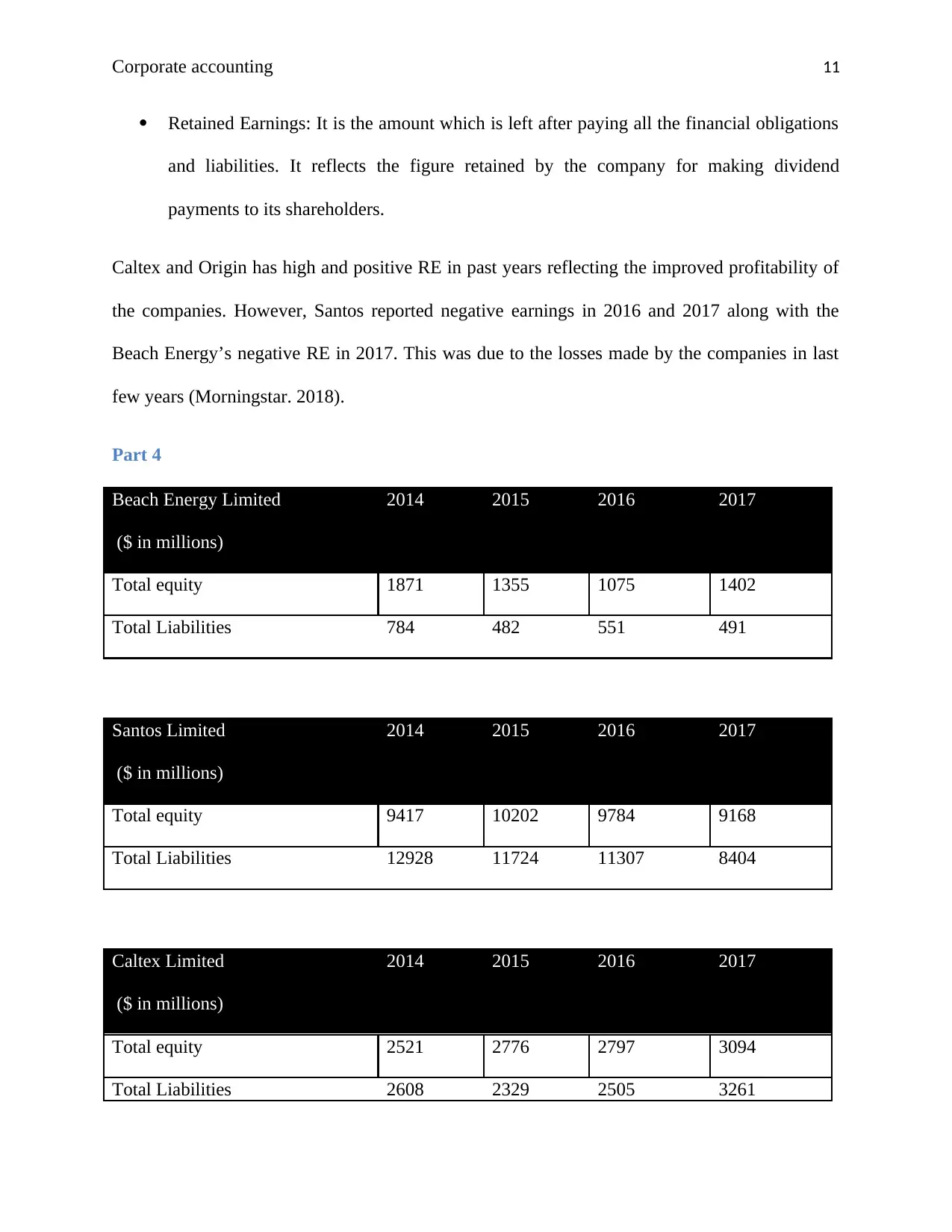
Corporate accounting 11
Retained Earnings: It is the amount which is left after paying all the financial obligations
and liabilities. It reflects the figure retained by the company for making dividend
payments to its shareholders.
Caltex and Origin has high and positive RE in past years reflecting the improved profitability of
the companies. However, Santos reported negative earnings in 2016 and 2017 along with the
Beach Energy’s negative RE in 2017. This was due to the losses made by the companies in last
few years (Morningstar. 2018).
Part 4
Beach Energy Limited
($ in millions)
2014 2015 2016 2017
Total equity 1871 1355 1075 1402
Total Liabilities 784 482 551 491
Santos Limited
($ in millions)
2014 2015 2016 2017
Total equity 9417 10202 9784 9168
Total Liabilities 12928 11724 11307 8404
Caltex Limited
($ in millions)
2014 2015 2016 2017
Total equity 2521 2776 2797 3094
Total Liabilities 2608 2329 2505 3261
Retained Earnings: It is the amount which is left after paying all the financial obligations
and liabilities. It reflects the figure retained by the company for making dividend
payments to its shareholders.
Caltex and Origin has high and positive RE in past years reflecting the improved profitability of
the companies. However, Santos reported negative earnings in 2016 and 2017 along with the
Beach Energy’s negative RE in 2017. This was due to the losses made by the companies in last
few years (Morningstar. 2018).
Part 4
Beach Energy Limited
($ in millions)
2014 2015 2016 2017
Total equity 1871 1355 1075 1402
Total Liabilities 784 482 551 491
Santos Limited
($ in millions)
2014 2015 2016 2017
Total equity 9417 10202 9784 9168
Total Liabilities 12928 11724 11307 8404
Caltex Limited
($ in millions)
2014 2015 2016 2017
Total equity 2521 2776 2797 3094
Total Liabilities 2608 2329 2505 3261
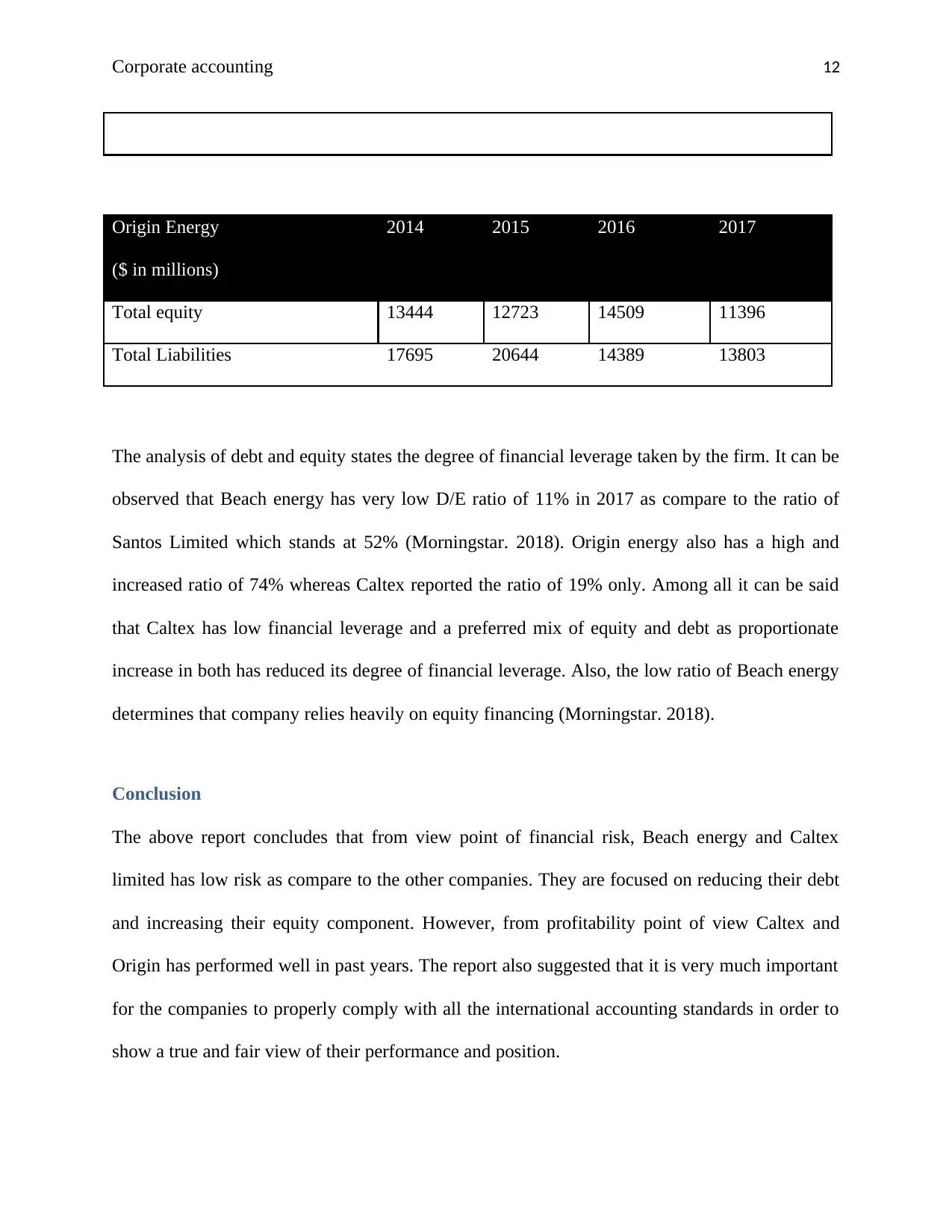
Corporate accounting 12
Origin Energy
($ in millions)
2014 2015 2016 2017
Total equity 13444 12723 14509 11396
Total Liabilities 17695 20644 14389 13803
The analysis of debt and equity states the degree of financial leverage taken by the firm. It can be
observed that Beach energy has very low D/E ratio of 11% in 2017 as compare to the ratio of
Santos Limited which stands at 52% (Morningstar. 2018). Origin energy also has a high and
increased ratio of 74% whereas Caltex reported the ratio of 19% only. Among all it can be said
that Caltex has low financial leverage and a preferred mix of equity and debt as proportionate
increase in both has reduced its degree of financial leverage. Also, the low ratio of Beach energy
determines that company relies heavily on equity financing (Morningstar. 2018).
Conclusion
The above report concludes that from view point of financial risk, Beach energy and Caltex
limited has low risk as compare to the other companies. They are focused on reducing their debt
and increasing their equity component. However, from profitability point of view Caltex and
Origin has performed well in past years. The report also suggested that it is very much important
for the companies to properly comply with all the international accounting standards in order to
show a true and fair view of their performance and position.
Origin Energy
($ in millions)
2014 2015 2016 2017
Total equity 13444 12723 14509 11396
Total Liabilities 17695 20644 14389 13803
The analysis of debt and equity states the degree of financial leverage taken by the firm. It can be
observed that Beach energy has very low D/E ratio of 11% in 2017 as compare to the ratio of
Santos Limited which stands at 52% (Morningstar. 2018). Origin energy also has a high and
increased ratio of 74% whereas Caltex reported the ratio of 19% only. Among all it can be said
that Caltex has low financial leverage and a preferred mix of equity and debt as proportionate
increase in both has reduced its degree of financial leverage. Also, the low ratio of Beach energy
determines that company relies heavily on equity financing (Morningstar. 2018).
Conclusion
The above report concludes that from view point of financial risk, Beach energy and Caltex
limited has low risk as compare to the other companies. They are focused on reducing their debt
and increasing their equity component. However, from profitability point of view Caltex and
Origin has performed well in past years. The report also suggested that it is very much important
for the companies to properly comply with all the international accounting standards in order to
show a true and fair view of their performance and position.
⊘ This is a preview!⊘
Do you want full access?
Subscribe today to unlock all pages.

Trusted by 1+ million students worldwide
1 out of 15
Related Documents
Your All-in-One AI-Powered Toolkit for Academic Success.
+13062052269
info@desklib.com
Available 24*7 on WhatsApp / Email
![[object Object]](/_next/static/media/star-bottom.7253800d.svg)
Unlock your academic potential
Copyright © 2020–2025 A2Z Services. All Rights Reserved. Developed and managed by ZUCOL.




